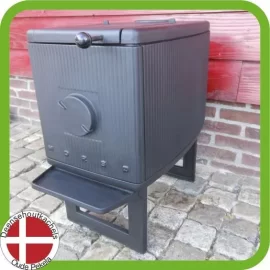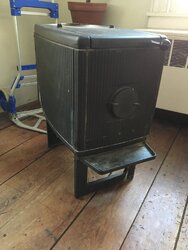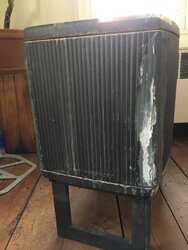Hi all, this will be my first post on this site, so hope all goes well. I've been in the wood heating game since I was born. My family heated (and still do) with wood as our primary and only source of heat, no backup. So, naturally I've decided to heat with wood myself and I have a wood working business, so I think wood is good  ....
....
Anyways, my girlfriend and I just acquired a Vintage Morso 6b Wood stove, for a fantastic deal too good to pass up. This is an awesome little stove and seems to be pretty obscure model. It is top loading and burns wood like a cigar, front to back. The baffles inside are all in great shape, and the rest is good, but...The back cast plate has 1 crack on each side right along/parallel to the corners. My questions are:
Can anyone shed some light on this stove? It looks to be a discontinued model produced from 1957-1986.
What should I do about the cracks? We really like this stove. I'm going to do what I can to get it into ship shape. If we could find a replacement plate, we'd buy it, but I'm having trouble finding ANY info on this gem. I can't weld myself and am not convinced that's the right fix. It looks like cast iron is tricky to weld, what with pre/post heating the cracked area.
Any help would be greatly appreciated as it's getting cold here in upstate NY!
 ....
....Anyways, my girlfriend and I just acquired a Vintage Morso 6b Wood stove, for a fantastic deal too good to pass up. This is an awesome little stove and seems to be pretty obscure model. It is top loading and burns wood like a cigar, front to back. The baffles inside are all in great shape, and the rest is good, but...The back cast plate has 1 crack on each side right along/parallel to the corners. My questions are:
Can anyone shed some light on this stove? It looks to be a discontinued model produced from 1957-1986.
What should I do about the cracks? We really like this stove. I'm going to do what I can to get it into ship shape. If we could find a replacement plate, we'd buy it, but I'm having trouble finding ANY info on this gem. I can't weld myself and am not convinced that's the right fix. It looks like cast iron is tricky to weld, what with pre/post heating the cracked area.
Any help would be greatly appreciated as it's getting cold here in upstate NY!




